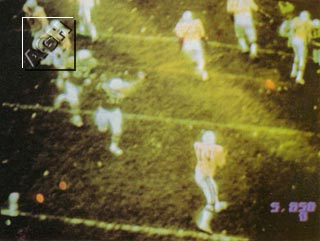GOAL TO GO
By Stern

Stern's interactive laserdisc football machine came at the wrong
time. Bally/Midway had beaten them to market with its own offering,
NFL Football, and Stern's offering pales by comparison in almost
every respect.
Goal to Go plays much like Stern's other laserdisc game, Cliffhanger.
After selecting a play on offense and seeing a diagram of the play,
you are shown laserdisc footage of the play's execution. Using a
four-position joystick, a "hands" and a "foot" button, you must
anticipate and mimic key actions of the quarterback and receiver
or ball carrier. For example, if you've called a rollout pass, you
must, on cue, pull the joystick down as the quarterback gets the
snap and fades back, push the stick to the right as he rolls-out,
push the "hands" button as he releases the pass, push the "hands"
button again as the receiver reaches for the ball, and then push the
joystick in the direction away from the defensive players involved
in the pass coverage. If at any time you miss a cue, the laserdisc
immediately cuts to footage of a sack, deflected pass, tackle, or
whatever. The "foot" button is used, as you might imagine, for
kicking field goals.
The game continues for as long as you continue to make first downs;
the contest ends with a loss of the ball on downs. Scoring is
based on both points scored and yards gained.
One problem with Goal to Go, as you might expect, is the lack of
true interaction in the game. You're not controlling the action
of the players as much as you're anticipating their preset movements.
Also, the strategic play calling element seems to be scaled-down
compared to Bally's NFL Football. If executed correctly, one
play seems to work as well as another. In two player games, opponents
take turns on offense -- there is no interactive defensive in
Goal to Go. Worse, the audiovisual effects of Goal to Go aren't
up to those displayed by NFL Football. For example, the computer
graphics used to illustrate play formations merely show an overhead
diagram of X's and O's; there is no play-by-play commentary and
crowd roar; worst there are no cheerleaders.
The generally uninspired laserdisc footage was shot on a Suburban
Chicago practice field using two local semi-professional football
teams. This is appropriate for a game that, in just about every
respect, is a step below the pros. Perhaps it should've been called
"USFL Football."
|


